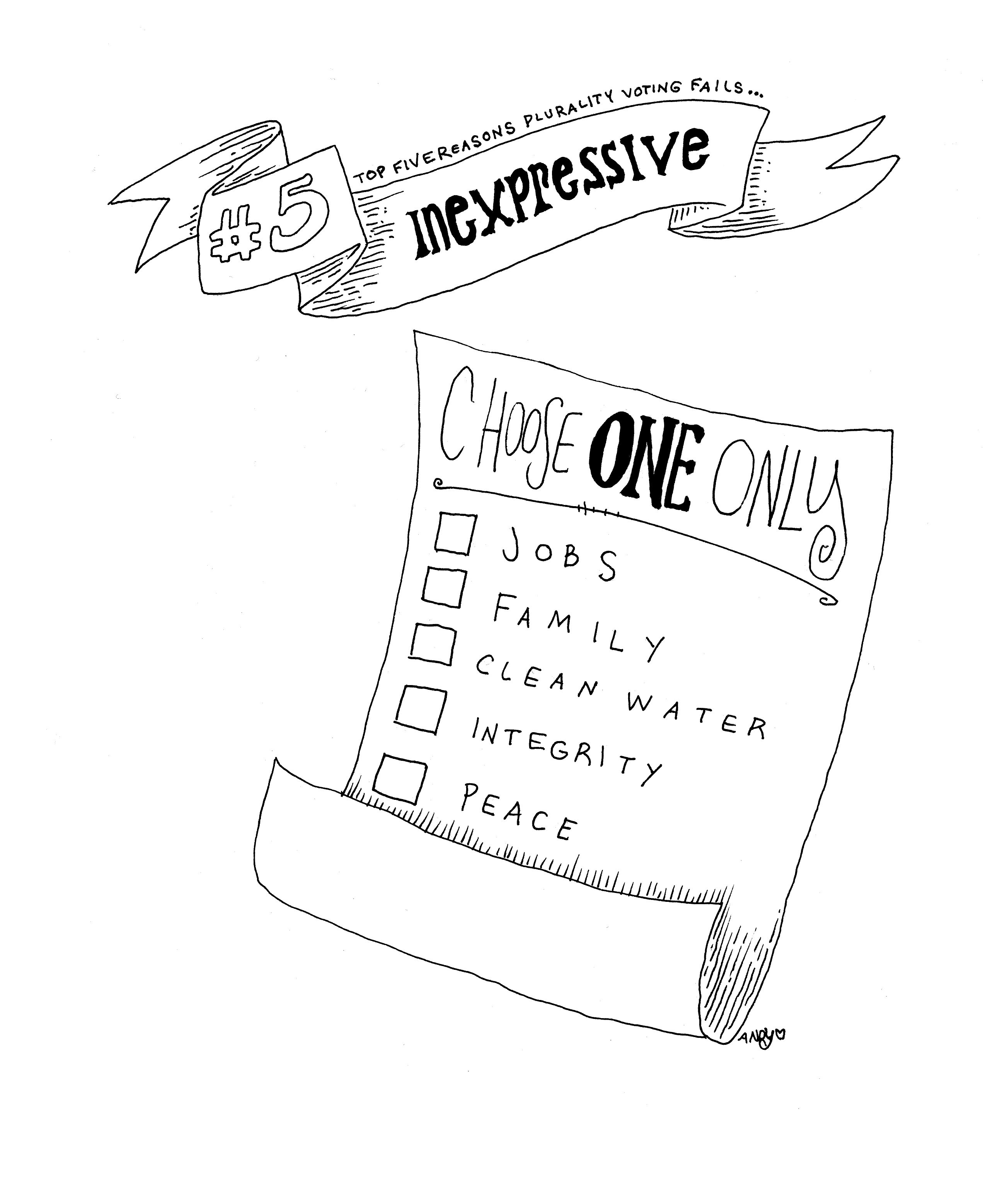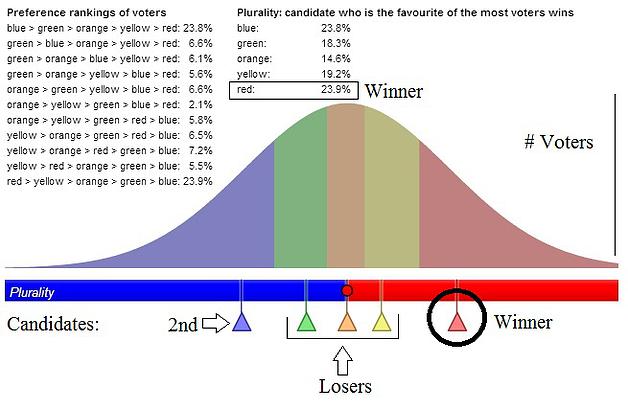The 5 Biggest Reasons Why Plurality Voting Fails

Black and white illustrations by Andy Schuler.
Any academic will tell you that our choose-one voting method (plurality voting) is a terrible, terrible voting method. (There’s better.) In fact, plurality voting is so bad that it deserves its own top five list.
Here it is.
Number 5: It’s Inexpressive
Plurality voting is among the least expressive voting methods there is. A plurality ballot puts a slate of candidates in front of you and forces you to choose only one. No more.
Consider how strange that is. You likely have opinions about all those candidates. And yet, you only get a say about one. Different voting methods allow you to express yourself in all kinds of ways, such as choosing as many as you want, ranking, and scoring. But plurality lets you do none of that.
Not convinced? Imagine a way to offer less information than plurality voting allows while not handing over a blank ballot. Good luck!
Number 4: The Spoiler Effect
Anyone awake during the 2000 U.S. presidential election is aware of the spoiler effect. In that election, we had a candidate that didn’t win (Nader) who divided another candidate’s support (Gore). Without Nader’s presence, Gore would have won; but with Nader present, Bush won. It makes no sense for a candidate to enter the race—and lose!—yet change the winner. But that’s the kind of nonsense plurality carries out.
Plurality voting is extremely sensitive to the spoiler effect. The “spoiler” candidate only needs to take away a little support from a similar candidate to sway the election. This happens because plurality only lets you choose one candidate. Because you can only pick one, voters are forced to divide their support among similar candidates.
The spoiler effect influences policy as well. It largely explains the U.S.’s draconian ballot access laws. Third parties and independents are often forced to quickly get many thousands — sometimes tens or hundreds of thousands — of signatures to get on the ballot.
To make matters worse, major parties then challenge those signatures to try to kick them off the ballot. In Pennsylvania, presidential candidate Ralph Nader was forced to pay court costs just for defending his own signatures. This heinousness plays out on the local level, too.
Why do major parties do this? Without a third or fourth candidate on the ballot, there’s no worry of a spoiler. Of course that also means voters don’t get options, but that’s not the major parties’ problem. So far, major parties have preferred to stifle competition and democratic speech than address the real culprit: plurality voting.
Number 3: Favorite Betrayal
Plurality voting can bully you into voting against your favorite candidate. It does this by giving you a dilemma: (1) Support the candidate you really want, but risk having another candidate you don’t like win; or (2) Make a compromise by choosing among the frontrunners, but abandon your favorite.
How good is a voting method that punishes you for supporting your honest favorite?
Not being able to vote for your favorite creates further issues. For instance, there’s less motivation to improve ballot access or get signatures for your candidate. After all, why work for better options if you can’t bring yourself to vote for them yourself?
Number 2: Partisan Winners
When multiple candidates enter a plurality voting election -- or advance through multi-candidate primaries — we tend to see more partisan winners. Why is that? There’s a phenomenon called the “center-squeeze” effect that works against moderate candidates appealing to the center. The effect looks like this:
The candidates in the middle have their vote divided and squeezed from either side while candidates on the ends pick up the support from either tail. If you had to pick a best candidate for this electorate, wouldn't you pick the candidate right in the middle that appeals to the broadest range of voters?
With all the talk about partisanship, you’d think there’d be more attention to this center-squeeze issue, but there isn’t. Instead we cross our fingers for “bipartisan agreement.” Of course, expecting bipartisan cooperation in such a partisan environment is a lot like a basketball player expecting a deliberate assist from the opposing team. Fat chance.
Number 1: Barrier to Entry
Barrier to entry doesn’t necessarily affect an election’s winner, but it does threaten political discourse, a crucial piece to a functional democracy. Plurality creates a barrier to entry by giving new candidates artificially low support — the consequence when voters fear to vote their favorites. This means that new candidates (including third parties and independents) don’t just lose. They lose big.
Our plurality voting approach is also taken with polling. They call people at dinner time: “If the election were held today, which candidate would you vote for?"
And that polling information is used in all kinds of ways, including who gets in debates. If candidates get too little support—which is what plurality does to newcomers—they don’t get in the debates. That means those candidates' ideas don’t get heard.
Media, too, consider plurality voting results when it comes to third parties and independents. Plurality's paltry showing for third parties is the media’s excuse for why they don’t cover those candidates. Media's reasoning to snub candidates goes something like this: “If their ideas were any good, they would have done better in the polls. They didn’t do well in the polls, so their ideas must not have been any good.”
The assumption here, however, was that the poll — using plurality voting — was any good in the first place. But we know that plurality voting is no good at all.
Unsurprisingly, third parties and independents rarely get anywhere. Plurality is so ingrained in us that we can’t have new ideas. It also tells us that even if a third party or independent gets on the ballot, we should dismiss them. Or maybe we should not even notice their presence.
Plurality voting's role means that we get stuck with two parties. And these two parties represent a narrow range of ideas. It’s little wonder why there’s seldom any real progress. Of course, that's not to say there can't be.
Editor's note: This article was originally published on The Center for Election Science's website on Monday, March 30, and has been edited for publication on IVN.
Photo Credit: Stephen Coburn / shutterstock.com










